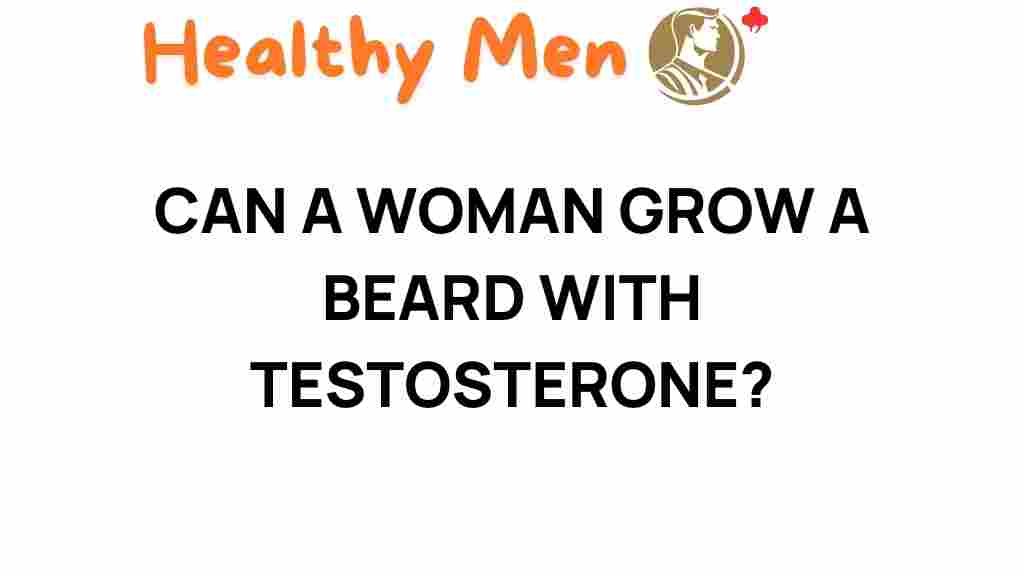The Surprising Truth: Can Women Really Grow a Beard with Testosterone?
When we think about facial hair, we often picture men with thick beards, but the conversation surrounding testosterone and beard growth is not exclusive to one gender. In recent years, the exploration of gender identity and the role of hormones in our bodies has opened up a fascinating discussion about whether women can grow facial hair, specifically beards, under certain conditions. This article delves into the relationship between testosterone and beard growth in women, examining the biological, health, and societal perspectives.
Understanding Testosterone and Its Role in Hair Growth
Testosterone is a hormone predominantly associated with male biological functions, but it is also present in women, albeit in smaller amounts. This hormone plays a crucial role in various bodily functions, including:
- Regulating libido
- Maintaining muscle mass
- Supporting bone health
- Influencing body hair growth
In women, testosterone is produced mainly in the ovaries, adrenal glands, and peripheral tissues. While the levels are significantly lower than in men, fluctuations in testosterone levels can lead to increased body hair, including facial hair. This condition is known as hirsutism.
The Biology Behind Beard Growth in Women
Beard growth in women is primarily influenced by hormonal balance. When testosterone levels rise, either due to natural variations or medical conditions, women may experience changes in their hair growth patterns. Here are some key biological factors that contribute to this phenomenon:
- Hormonal Imbalances: Conditions like polycystic ovary syndrome (PCOS) can lead to elevated testosterone levels in women, resulting in increased body hair.
- Genetics: Some women may have a genetic predisposition to grow facial hair, which can be exacerbated by hormonal changes.
- Age and Menopause: As women age, hormonal changes during menopause can also affect hair growth patterns.
Step-by-Step Process: How Women Can Manage Facial Hair Growth
If a woman finds herself with an increase in facial hair due to higher testosterone levels, there are various methods for managing this change. Here’s a step-by-step process:
Step 1: Consult a Healthcare Professional
Before taking any action, it’s essential to consult with a healthcare provider. They can assess hormone levels and determine if there is an underlying condition that needs treatment.
Step 2: Understand Your Hormonal Profile
Getting a comprehensive hormonal profile can provide insights into your testosterone levels. This can help in understanding the cause of increased facial hair growth and identifying potential treatments.
Step 3: Explore Treatment Options
Depending on the diagnosis, treatment options may include:
- Medications: Anti-androgens like spironolactone can help reduce testosterone effects and hair growth.
- Hormonal Therapy: Hormonal treatments may balance testosterone levels.
- Laser Hair Removal: This cosmetic procedure can effectively reduce unwanted facial hair.
- Electrolysis: A permanent hair removal method that targets individual hair follicles.
Step 4: Consider Lifestyle Changes
Incorporating healthy lifestyle choices can also play a role in managing hormone levels. Some tips include:
- Maintaining a balanced diet rich in whole foods
- Engaging in regular physical activity
- Managing stress through mindfulness and relaxation techniques
Troubleshooting: Common Concerns and Misconceptions
As with any health-related topic, several misconceptions surround the idea of women growing beards due to testosterone. Here are some common concerns:
Misconception 1: All Women with High Testosterone Will Grow Beards
While increased testosterone can lead to facial hair growth, not all women with elevated levels will experience this. Individual responses to hormones vary significantly.
Misconception 2: Facial Hair Equals Masculinity
Societal norms often link facial hair with masculinity, but this perception is evolving. Many women embrace their body hair as part of their identity and beauty.
Misconception 3: There’s No Solution for Unwanted Facial Hair
There are numerous effective treatments available. Women experiencing distress due to unwanted facial hair should consult healthcare professionals to explore options.
The Intersection of Beauty Standards and Gender Identity
The conversation around beard growth in women also intersects with broader discussions on beauty standards and gender identity. In many societies, traditional beauty standards favor smooth, hair-free skin for women. However, this perspective is changing as more individuals embrace their authentic selves, regardless of societal expectations.
Women who grow facial hair may find themselves challenging conventional beauty norms. This act of defiance can be empowering, allowing them to redefine their identity outside traditional gender roles.
Societal Impact and Changing Perspectives
As society progresses toward greater acceptance of diverse gender identities, the stigma surrounding body hair in women is gradually diminishing. Movements advocating for body positivity encourage individuals to embrace their natural appearance, promoting self-acceptance and encouraging discussions about gender and beauty.
Moreover, awareness about conditions like PCOS and their impact on body hair growth is increasing. This growing understanding fosters a supportive environment where women can discuss their experiences without fear of judgment.
Conclusion: Embracing the Complexity of Body Hair and Identity
The relationship between testosterone, beard growth, and women is complex and multifaceted. While hormonal influences can lead to facial hair growth, the conversation extends beyond biology to encompass personal identity and societal perceptions. Women are increasingly challenging beauty standards and embracing their unique traits, including body hair.
Ultimately, understanding the biology behind hair growth, exploring treatment options, and fostering a more inclusive society can empower women to navigate their experiences with confidence. Whether they choose to embrace or manage facial hair, the journey is deeply personal and reflective of their identity in a world that is slowly but surely becoming more accepting of diversity.
For more information on hormone health and its impact on women, visit this resource. If you’re interested in understanding more about the societal impacts of body hair, check out this study.
This article is in the category Conditions and created by healthymen Team
